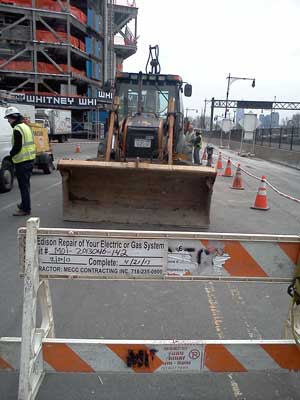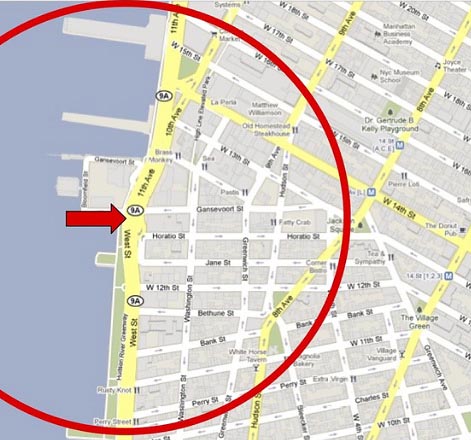BY EILEEN STUKANE | The first natural gas transmission pipeline to be constructed in New York City in 40 years has arrived, in the form of the Spectra Energy Pipeline. This 30-inch pipeline makes its way for 15.2 miles from Staten Island, through Bayonne, New Jersey and Jersey City, before it travels under the Hudson River and arrives at its destination at the Gansevoort Peninsula at the edge of the Meatpacking District — and at the doorstep of the soon-to-be completed Whitney Museum. It is here, at approximately Tenth Avenue and Gansevoort Street, that Con Edison is currently excavating to begin a dig that will make a Con Ed pipeline connection with the 30-inch Spectra Pipeline and move the natural gas uptown to its link with the Con Ed distribution system at West 15th Street.
West Village and Chelsea residents, along with Community Boards 2 and 4 (CB2, CB4) are concerned that the presence of a Spectra Pipeline in the area will present danger to public safety and further encourage the practice of hydraulic fracturing, or hydrofracking, of the Earth’s shale — a method known to leave cancer-causing chemicals in water supplies near hydrofracked sites. Environmental activists have had good reason to resist its construction. Looking at the bigger picture, groups such as the Sane Energy Project and Occupy The Pipeline are working to move the planet away from dependence on fossil fuel — acquired in ways harmful to the environment — and toward renewable forms of energy. Natural gas is a fossil fuel that is the result of the prehistoric settlement of marine sediment. It is especially present in the Marcellus Shale that exists thousands of feet below ground from West Virginia, through Pennsylvania, a bit of Ohio and along the west side of the Hudson River in New York.
While New York City itself will not be hydrofracked, residents of Chelsea have joined West Villagers in their concern about the safety of both the Spectra Pipeline and the Con Ed connector pipeline, the pressure of the traveling gas, and the gas’s potentially cancer-causing radon content.
Radon — a tasteless, odorless, colorless gas — is a component of natural gas produced during the radioactive decay of minerals that are present in shale (minerals that are particularly high in Marcellus Shale). Inhalation of radon is the leading cause of lung cancer among nonsmokers and the second leading cause among smokers. “Our position is that pipeline oversight in general is inadequate and even if there was proper oversight, which we don’t believe is being applied in this case, it still doesn’t obviate the radon risks nor the spreading of the demand for hydrofracked gas,” says Patrick Robbins of Occupy The Pipeline.

Con Edison has begun work in preparation for the installation of new gas facilities in connection to a gas pipeline to 10th Ave., btw. Gansevoort & W. 15th Sts.
HOW SAFE IS THE NEIGHBORHOOD?
Although Mayor Bloomberg has not spoken directly to Manhattanites to explain the need for another natural gas pipeline into New York City, the Spectra Pipeline was constructed as part of his PlanNYC — a program initiated in 2007 to combat climate change by creating a greener New York City, which would in turn have a stronger economy.
PlanNYC requires that the dirtiest type of heating oil, Number 6, and a slightly less dirty, Number 4, be phased out. By 2015 Number 6 must be eliminated — and by 2030, all buildings must convert to boilers that use a cleaner fuel (such as natural gas, which currently costs less than fuel oil). To encourage gas conversion, utility companies have created incentive programs and city-administrated grants are available to cover costs. And so the bureaucratic groundwork was laid for an increased need for natural gas and the Spectra Pipeline arrived.
Worry set in early on when, after receiving $2.75 million from Spectra Energy, the Hudson River Park Trust granted access for Spectra Pipeline construction on the Gansevoort Peninsula — only 300 feet from a children’s playground. A watchdog group, naturalgaswatch.org, reported that in 2012, Texas Eastern Transmission (a division of Spectra Energy) received $134,000 in fines when it was cited by the Pipeline and Hazardous Materials Safety Administration for failing to monitor and control for pipeline corrosion. This news, plus recent pipeline explosions in Massachusetts, Pennsylvania, West Virginia and the 2010 San Bruno, California explosion that killed eight people and destroyed 38 homes, have made residents very nervous.
At a CB2 meeting in October 2011, Ed Gonzales, Project Director of Spectra, was questioned about Spectra’s safety record and the San Bruno explosion. He spoke about the pipeline having a “higher strength and wall thickness than required by federal regulations,” about the fact that the San Bruno pipeline “was not an interstate pipeline” and how Spectra has “levels and layers of protection” and “robotics that would be run through the pipeline to inspect it.”
At a February 14 CB4 meeting about the Con Ed connection, Anthony Leto, Con Ed’s section manager in gas engineering, reiterated what he had said at a previous CB2 meeting — that the pipeline connection to Spectra and its extension up Tenth Avenue would be inspected daily, and that safety features to prevent catastrophe were built into the hydraulic operations with remotely operated valves, battery backups and phone monitoring. However the high pressure of the gas within the pipeline remains a concern.
The Spectra Pipeline transmits the natural gas interstate at a pressure of at least 1000 psi (pounds per square inch). However, as Mr. Leto reported, that pressure gets “stepped down” in Bayonne, New Jersey to 350 psi — which is how it arrives at the Gansevoort Peninsula. The question then is at what pressure is it traveling up Tenth Avenue. There are 16 underground regulating stations (which in the utility business can be referred to as “vaults”) in Manhattan that reduce the pressure down from the 350 psi system to 99 psi, 15 psi, or lower. Chelsea Now repeatedly asked a spokesperson for Con Edison exactly where the pressure was reduced from 350 psi in the system, and the answer was always the nonspecific “at the 16 regulating stations” (which are beneath those vented manhole covers you see on the street).
If there is some comfort to be had, it may be that there has been natural gas delivered to Manhattan, both Midtown and Uptown, in 350 psi since the 1950s. One pipeline is a 30-inch pipeline and the other is a double pipeline of 24 inches each. We are living over an 88-mile network of pipelines in New York City (14 miles in Manhattan) and so far, no major explosions. The explosion at the Con Ed substation at East 14th Street and Avenue C during Superstorm Sandy was not natural gas, but an electrical blowout. CB4 has drafted a letter (expected to be approved by the full board on March 6) to the President/CEOs of both Con Edison and Spectra Energy requesting “periodic official reporting of safety tests on the Con Edison gas distribution system” as well as “assurances that the gas flowing at any pressure does not pose a high explosion risk.”
RADON IN THE KITCHEN?
Natural gas hydrofracked from the Marcellus Shale has a potentially higher content of radon than natural gas from other parts of the country. While Governor Cuomo has delayed his decision on allowing further fracking of the Marcellus Shale in the state of New York, there is still Marcellus Shale gas being hydrofracked in West Virginia and Pennsylvania. The story of radon — which is an intrinsic component of natural gas — is that while it is radioactive, it has a relatively short half-life of 3.8 days, after which its concentration is halved. After another 3.8 days, it’s a fourth of the original. It dissipates quickly and since the natural gas the city has been receiving has taken a six to eight-day trip from the Texas-Louisiana Coast, it is fairly diluted on arrival. Natural gas from the Marcellus Shale in Pennsylvania or New York headed to New York City travels an estimated 10 miles per hour to arrive in less than a day. This gives radon’s radioactivity little time to diminish. Although the possibility that storage tanks could be constructed to hold the gas and allow time for the radon to dissipate, Spectra has no plans to do so. The Federal Energy Regulatory Commission’s Environmental Impact Statement did not consider radon to be a safety issue.
The Environmental Protection Agency cites 4 picocuries per liter as the safe level in homes. In its draft letter, CB4 has also requested from Con Ed and Spectra, “a periodic statement by an independent body reporting the test results for radon, and a list of other impurities potentially found in the gas we use to cook.” In order to get a baseline reading for homes in Manhattan, Sane Energy Project has undertaken the NYC Citizen’s Radon Testing Program.
Anyone who lives in the five boroughs and cooks with a gas stove can sign up to receive a testing kit from Sane Energy, by mail, for $18. For info, visit saneenergyproject.org/2013/02/23/announcing-the-nyc-citizen-radon-testing-program/. Readings from the test will be compared to readings taken after the natural gas from the Spectra Pipeline arrives.
Note: This Notice was issued by Con Edison on February 20, 2013. Preparatory work at the site is underway.
Public Notice From Con Edison Gas Infrastructure Upgrades
Tenth Avenue between Gansevoort and West 16th Streets
As early as Monday, February 25, 2013 to mid-March, 2013, Con Edison will be doing work in preparation for the installation of new gas facilities in connection to a new gas pipeline to Tenth Avenue between Gansevoort and West 15th Streets. The project is necessary to meet the energy needs of our customers. We are planning to work at the following locations:
1. 10th Avenue (service road), Gansevoort Street to West 14th Street (5 locations) 7am to 7pm Monday through Friday 9am to 7pm Saturday and Sunday
2. 10th Avenue, West 15th to West 16th Streets 9am to 3pm Daily (Weekdays and Weekends)
Schedule subject to change.
This work to expand our gas intrastructure is part of our partnership with building owners and the City of New York to reduce emissions and improve air quality by converting buildings burning #4 and #6 oil to cleaner-burning natural gas. We apologize for any inconvenience this work may cause. For more information, please contact Public Affairs at 212-460-6427, or email ManhattanPA@conEd.com.


















